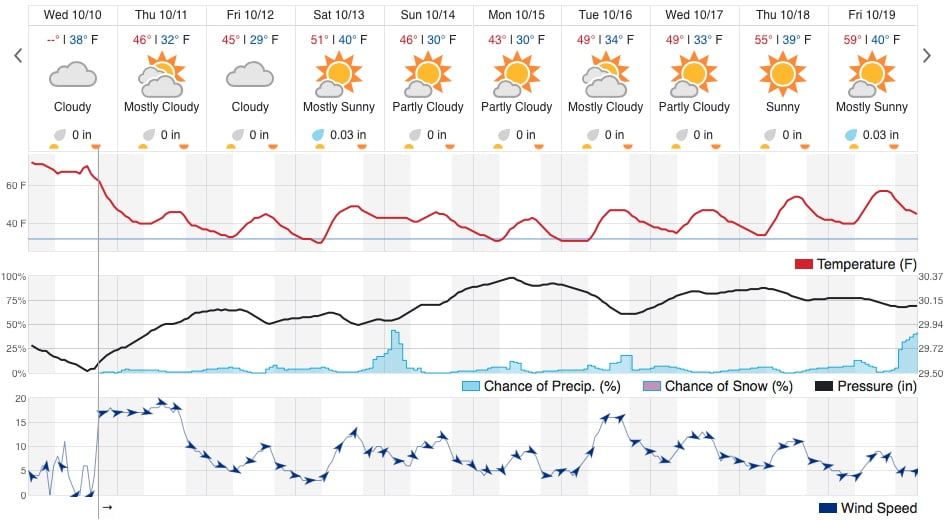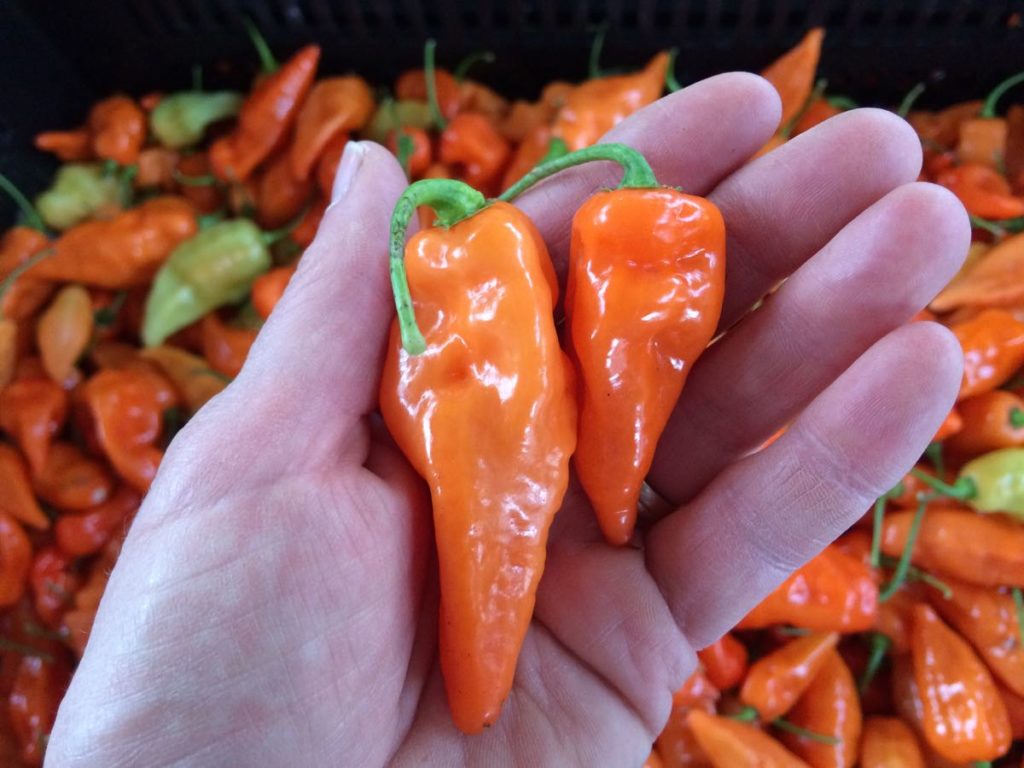Week #21, October 11, 2018
- On: October 10, 2018
 0
0
Farm News

It’s likely to frost this week. Watch the sky as the cold front moves in. Sunsets can be spectacular. I took this photo on September 28, the night before our first, very light frost which barely nipped at the crops.
The upcoming cold weather will do more damage. Hey, it’s mid-October and time for this change. Look at the low temperatures predicted for next few days: 32, 29, (40), 30, 30 oF. We’ve started stripping peppers before they get damaged. You’ll get a bunch of bell peppers this week, many of them green. We plan to protect a few crops with lightweight row cover (fennel, other peppers) but everything else should be able to handle the cold. Cauliflower, Romanesco, root crops, and Brussels sprouts take these temperatures in stride. Tender crops like sweet potatoes and winter squash are tucked away in heated spaces.
Look at the precipitation forecast! There’s almost no rain coming. Steve asked that I tell you we got only 2 inches of rain this week. After this summer, he says “it doesn’t count as a wet week unless we get 4 inches.” For perspective, we’re happy to get 4 inches during a typical summer month.
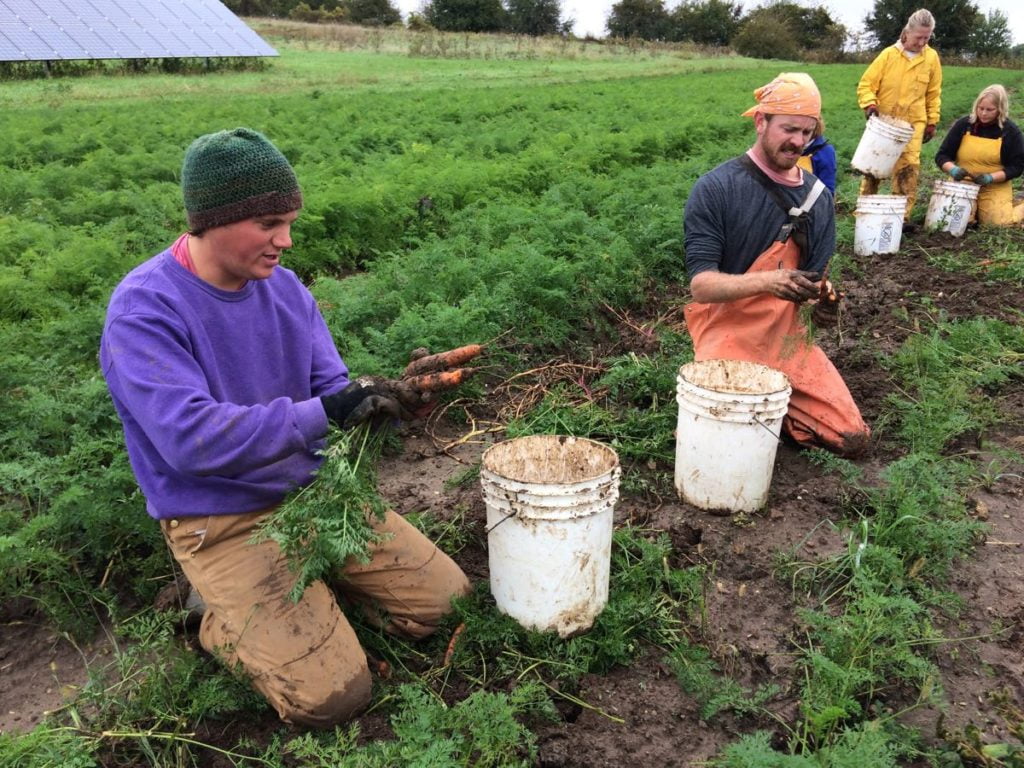
We harvested your carrots by hand again this week, grubbing them out of muddy ground. Jory and Billy might be exaggerating the difficulty of the job but not the mud.
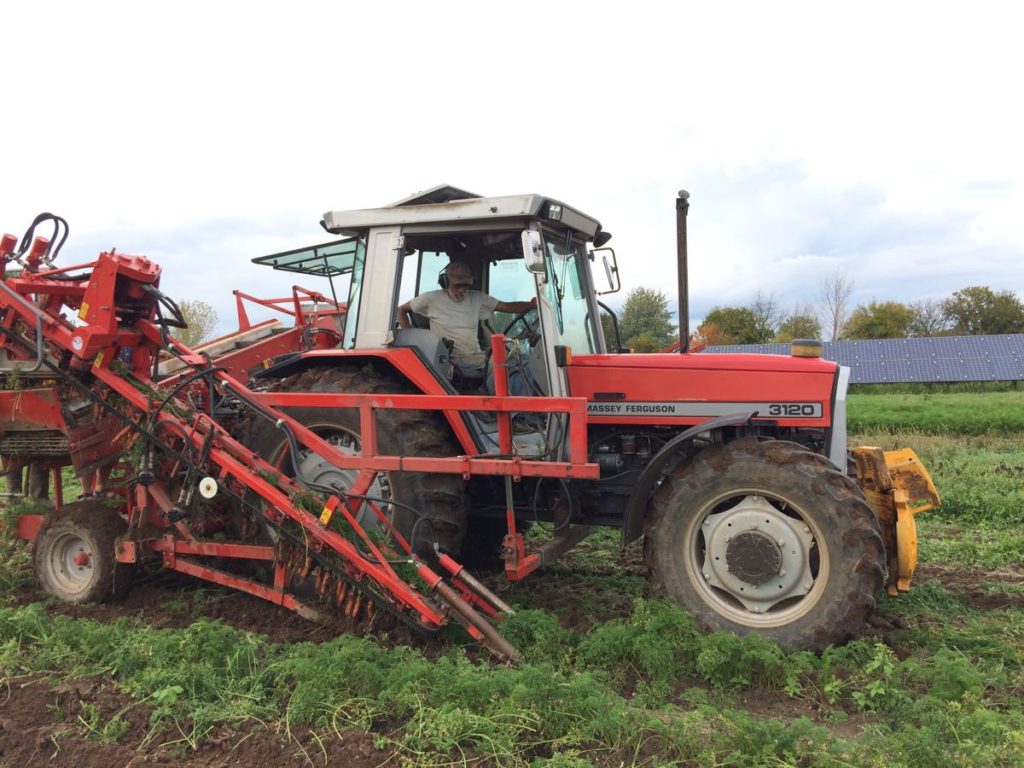
By mid-week, the ground was dry enough for Steve to use our mechanical carrot harvester. He considered trying earlier this week but we talked him out of it. If that tractor gets stuck in the mud, we don’t have anything powerful enough to pull it out. We’d have to call in a tow rig and that’s expensive and embarrassing. Beth
Garlic harvest
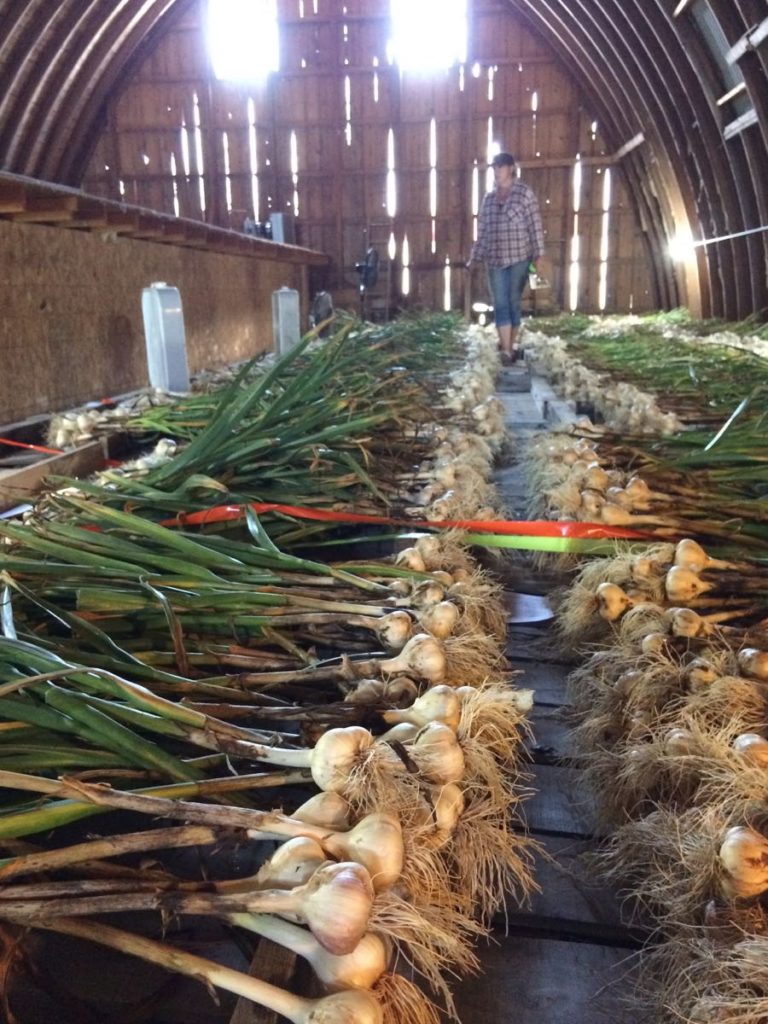
Garlic drying in our barn loft soon after harvest in July. Our barn is a good place for this, dry with good ventilation. We lay the garlic on overturned wooden bins, the same bins we will soon fill with carrots for winter.
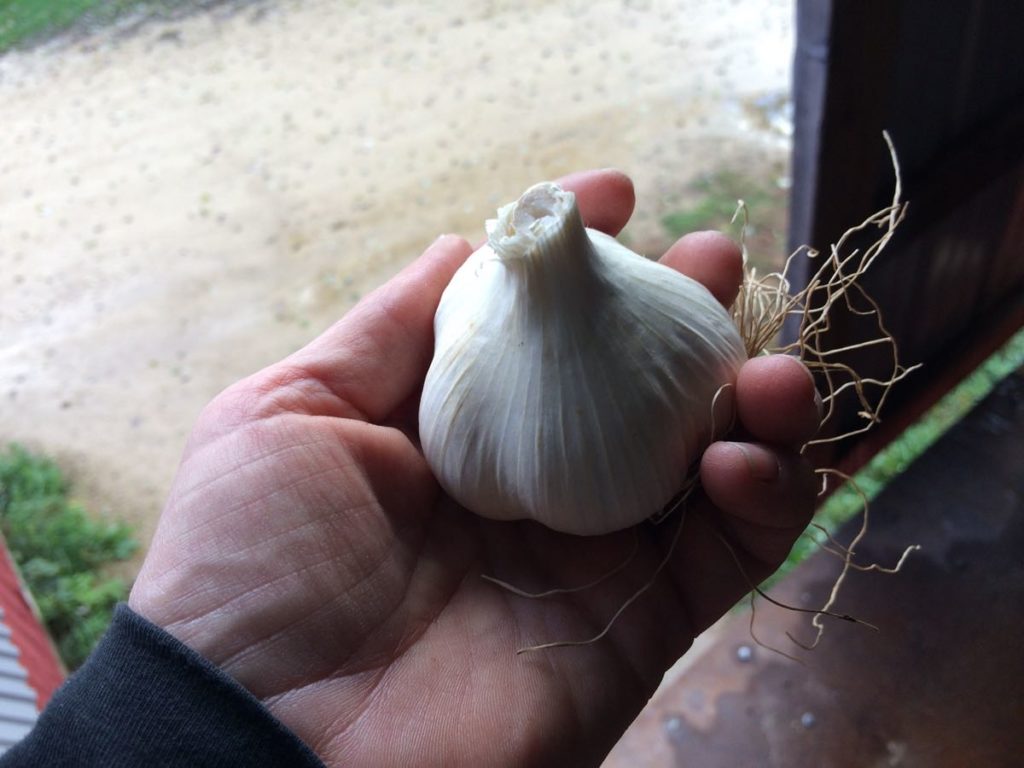
This year’s garlic has nice, plump cloves.
Our garlic crop is excellent this year, the best we’ve ever grown. Unfortunately, it was a terrible year for many garlic farmers in the midwest, including our friend John Hendrickson who lost his entire crop. He thinks his garlic was damaged during the warm spell in February. Snow melted, then froze again in sheets. That’s hard on garlic. John usually grows about half our CSA garlic, so this is a big loss. I’ve checked around and (not unexpectedly) there is little good-quality local garlic available for sale.
Fortunately, we scaled up our garlic planting last fall, with plans of packing more in the CSA boxes. We will use that larger harvest to plant an even bigger field this fall, so we can grow all your garlic and not rely on someone else. We were lucky in our field choice last year. We planted in a small, elevated field with good drainage and laid down an unusually thick mulch. I think that’s what saved our crop this winter: good drainage and a thick mulch. We’ll try to replicate those conditions when we plant this year. I’ve held off packing garlic in the CSA boxes while we had good herb options growing outside. We’ll deliver nice bulbs over the coming weeks. Beth
Veggie List and Veggie Notes
Week #21, October 11/12, 2018
– weekly shares
– green EOW
Sweet potatoes, ~2.5 lb
Carrots, 2 lb
Kale, Red Russian or lacinato or green
Celery
Leeks, 2 skinny, ~1/2 lb
Daikon radish, ~1 lb
Bell peppers, 5?, mostly green, maybe 1 fully or partially colored
Oranos snack pepper, 2 or 3
‘Habanada’ not-hot habanero, 2
(in bag with carrots to distinguish from the Oranos)
Yellow onion, 1
Garlic, 1
Each site gets an item from this list:
broccoli OR cauliflower OR Romanesco cauliflower OR purple cauliflower OR globe eggplant
Next week’s box will probably contain butternut squash, beets, peppers, onions, garlic and more.
‘Beauregard’ sweet potatoes – Here are a few things we’ve learned about sweet potatoes:
– For best flavor, cook your sweet potatoes so they brown and caramelize. We have a simple, favorite way to roast sweet potatoes. We used to prepare sweet potato fries in the oven. Now we just quarter the potatoes, rub with olive oil, dust with salt and place cut-side-down on a cookie sheet. Roast in a 450 F oven without turning until soft. The flavors will caramelize (like sweet potato fries) but preparation is simpler and the cooking time less exacting. Slender sweet potato fries go from undercooked to overcooked in the blink of an eye. Larger slices are less exacting, and therefore are easier. Small sweet potatoes can be cut just in half. Jumbos will need to be chopped into pieces. Otherwise, they will take a long time to cook.
– Store your sweet potatoes at room temperature. They suffer chilling injury below 50 F.
– The sweet potatoes we grow require slightly longer cooking than ones from the supermarket, perhaps because they contain higher moisture so soon after harvest.
– Sweet potatoes are good at any size. We have cooked everything from tiny to jumbo and consistently find that all sizes taste good.
Kale – You’ll receive either Red Russian (pink midveins) or lacinato (dark green and bumpy) or green kale (medium green, with wavy leaf edges). All are from fields in good shape. The kale is tender enough to use raw but can be cooked too.
Celery – Our celery is more strongly flavored and more fibrous than typical grocery store celery. Taste it raw then decide how you want to use it, raw or cooked. This is one of our better batches of celery, which we pack in the CSA boxes just once per year. We’ve pushed the planting date later. We want to avoid summer harvests because the celery is tough if it matures during hot weather. Harvest too late in the fall and insect problems accumulate. Who knew celery is so finicky to grow?
Leeks – Well, this is not our best leek crop. You will receive two spindly little leeks this week. They were in a wet field this year and we lost control of the weeds. They’ll be better next year.
Daikon radish (long white root(s)) – This is a Japanese radish, good cooked or raw.
Ideas: (i) We specifically send the daikon with carrots so you can make mixed grated carrot and daikon salad. Dress with a simple marinade of rice vinegar, mirin, soy sauce, sesame oil and a pinch of sugar. Even a brief marination mellows the radish’s sharpness.
(ii) I look forward to making Cubed Radish Kimchi. You can ferment it if you wish but I often just eat it fresh.
Storage: Cover and refrigerate.
Bell peppers – It has been a poor pepper year. We usually send many more peppers in the fall CSA boxes. Unfortunately, most large peppers rotted during the rain. Now that frost looms, we’ve begun stripping the pepper fields, and will have bell and frying peppers for another week or two. You’ll get more green peppers than red, yellow or orange.
To preserve, simply freeze your raw peppers. You can do this with bell or frying peppers of any color. Chop raw peppers into bite-sized pieces. Load into a freezer bag and freeze. No need to blanche.
‘Habanada’ peppers – These are an experiment, so we have only two small ones per CSA box but we want to share them because they are interesting. They are packed in the carrot bag, to avoid confusion with the Oranos peppers. These are habanero chiles with all the heat bred out of them. Lo and behold, habaneros have a wonderful fruity flavor. No one knew because the blazing heat of a traditional habanero sears your taste buds. I suggest you just eat them to enjoy the flavor. These were developed through a collaboration between chefs and plant breeders. Go here if you are interested in the background story.
RECIPES
Visit our 2018 Recipe Log or our 2017 Recipe Log or join our Facebook discussion group.
LOCAL THYME/ Comforting Classics
Creamy Chicken and Wild Rice Soup
Baked Beans
Grilled Maple Glazed Sweet Potato
Grilled Steak with Carrot Daikon Salad
LOCAL THYME/ Outside the Box Recipes
Shrimp or Bean Filé Gumbo
Rice Noodles with Chicken, Carrots and Peppers
Kale and Sweet Potato Salad with Roasted Garlic Dressing
Chinese Chicken Noodle Soup with Star Anise
LOCAL THYME/ Quick & Easy Meal
Kale Carrot Juice
RECIPES FROM LAUREN
ROASTED VEGETABLES WITH WHITE MISO TAHINI SAUCE
Adapted from Smitten Kitchen
Serves 4
Takes 1 hour
1/4 cup olive oil, divided
1-1/2 teaspoons Kosher salt, divided
1/2 teaspoon freshly ground black pepper
2 pounds sweet potatoes, peeled and cut into 1-inch cubes
1 head broccoli OR cauliflower OR romanesco, cut into florets
2 small leeks, cut into thick slices
1 bunch kale, stems removed and torn into bite-size pieces
1-2 cooks favorite cooked grain (wild rice is great here!), optional
White Miso Tahini Sauce
1 garlic clove
1/4 cup rice wine vinegar
2 tablespoons white miso
2 tablespoons tahini
2 tablespoons soy sauce
2 tablespoons olive oil
1 tablespoon honey
- Preheat oven to 400 degrees.
- Toss sweet potatoes with 2 tablespoons olive oil, 1/2 teaspoon Kosher salt and 1/4 teaspoon pepper on a large baking sheet. Place in oven while you cut broccoli (cauliflower or romanesco) and leeks. These will take 5-10 minutes longer than these other veggies.
- Toss broccoli and leeks with additional tablespoon olive oil, 1/2 teaspoon Kosher salt and 1/4 teaspoon pepper on a second large baking sheet. Add to oven and set timer for 30 minutes.
- Add kale to broccoli pan. Drizzle with remaining olive oil and sprinkle with remaining salt and toss gently with broccoli and leeks. Place in oven and roast (along with sweet potatoes) for 20 minutes more.
- Meanwhile, prepare you sauce by combining all ingredients in a blender or food processor and mix until smooth.
- Toss all roasted veggies together and drizzle with sauce immediately before eating. If you want to beef it up, toss veggies with a favorite grain right after they come out of the oven.
.
SESAME NOODLE BOWL WITH PORK MEATBALLS & PICKLED VEGGIES
Inspired by Dishing up the Dirt
Takes 1 hour
Serves 4-6
Pickled Veggies
1/2† cup rice wine vinegar
1/4 cup sugar
1 tablespoon toasted sesame oil
1 teaspoon Kosher salt
3 carrots, cut into matchsticks
1 pound daikon (all the daikon you got), cut into matchsticks
Pork Meatballs
3-4 stalk celery, with leaves, roughly chopped
2 habanada peppers, stems and seeds removed
3 garlic cloves, peeled
1/4 cup fish sauce
1 tablespoon sriracha
2 pounds ground pork
1 tablespoon peanut (or olive) oil
Noodles
1/2 pound Soba noodles
1/4 cup maple syrup
1/4 cup soy sauce (or tamari)
2 tablespoons rice wine vinegar
2 teaspoons toasted sesame oil
1 green pepper, finely chopped
1-inch ginger, peeled and minced
1 clove garlic, minced
1/4 cup peanut (or olive) oil
- In a medium bowl, combine vinegar, sugar, oil and salt for pickled veggies. Whisk until smooth and then stir in carrots and daikon. Let sit and pickle while you work on the rest of your meal.
- Preheat oven to 400 degrees.
- In the bowl of a food processor combine celery, habanada peppers, garlic, fish sauce and sriracha. Process until everything is finely chopped and well-combined. Add pork and process until all the beautiful celery mixture is incorporated into the pork.
- Shape pork mixture into meatballs about the size of a golf ball. My mixture yielded just under 40. The size doesn’t matter too much but go for no more than 45 and no less than 30 to ensure they cook all the way through.
- Drizzle baking sheet with 1 tablespoon oil and place meatballs on it. Bake for 30 minutes. Drain grease halfway through if you like. The meatballs are cooked through at this point. If you want them to have a little more browning (as I usually do), you can absolutely heat some more oil in a skillet and cook the meatballs on high heat for 2-3 minutes, turning as you go until browned on all sides.
- Bring a large pot of salted water to a boil. Add soba noodes and cook according to package directions.
- Meanwhile, combine maple syrup, soy sauce, vinegar, sesame oil, green pepper, ginger, garlic and olive oil in a large bowl. Whisk to combine. Once noodles are cooked (and drained), add to this mixture. Use a tongs to evenly coat.
- Serve a bowl of noodles with meatballs and drained pickled veggies. Add a bit of sriracha if you like a bit more heat.
.

